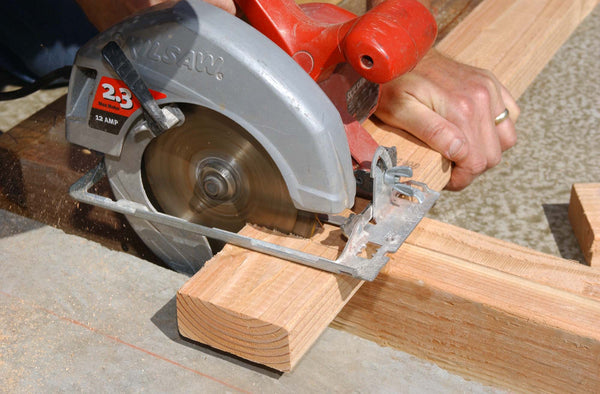

How to Cut Wall Paneling Like a Pro in 9 Easy Steps
Are you ready to elevate your DIY game and give your home a fresh, modern look? Cutting wall paneling is an essential skill for anyone looking to transform their living space.
Whether you're a seasoned DIY enthusiast or just starting, this beginner's guide will teach you how to cut wall paneling like a pro. We'll walk you through the process step by step, sharing tips, tricks, and safety precautions along the way.

Read more: 5 Best wood wall paneling ideas: From Rustic to Ultra-Modern!
Before the Panels Hit the Wall: Important Considerations for Installation Success
Wall panels offer a fantastic way to transform your space, adding style, texture, and even functionality. But before you get swept away by the vast array of options and dive headfirst into installation, there are some crucial factors to consider. Here's a quick checklist to ensure a smooth and successful wall panel installation process:
- Measure Twice, Cut Once: This age-old adage applies perfectly to wall panels. Meticulously measure your walls, taking into account windows, doors, electrical outlets, and any other existing fixtures. Factor in any necessary cuts around these elements to ensure a seamless final look.
- Assess Your Walls: Not all walls are created equal. Make sure your wall surface is clean, level, and free of debris. Uneven surfaces can lead to uneven paneling, so consider if any patching or sanding is needed beforehand. Additionally, identify the wall material (drywall, plaster, etc.) to choose the appropriate installation method and ensure proper adhesion.
- Plan Your Panel Layout: Visualize the final design! Sketch out a layout plan, especially for intricate patterns or large rooms. This helps determine panel placement, minimize cutting waste, and achieve a balanced and aesthetically pleasing look.
- Understand the Installation Process: Familiarize yourself with the specific installation instructions for your chosen wall panel system. Different materials might require different adhesives, fasteners, or techniques. Reading the instructions beforehand allows you to identify any potential challenges and plan accordingly.
- Consider Professional Help: For complex installations or if you're a DIY novice, don't hesitate to consider hiring a professional. They have the expertise and experience to ensure a flawless installation and can save you time and frustration in the long run.
The Tools You'll Need
Before we dive into the cutting process, let's make sure you have the right tools for the job. To cut wall paneling like a pro, you'll need:
- Measuring Tape: Accurate measurements are the foundation of any successful DIY project.

- Pencil: For marking your paneling and ensuring precise cuts.

- Circular Saw or Jigsaw: The choice between these two depends on the type of wall paneling you're working with.

- Straight Edge or T-Square: To guide your saw for straight cuts.

- Safety Gear: Don't forget your safety glasses and ear protection.

Read more: How to Remove Panel from Wall: A Step-by-Step Guide
Step to Step Cut Wall Paneling
Step 1: Measure Twice, Cut Once
Start by measuring the area where you intend to install the wall paneling. Measure the length and height of the wall, and mark these dimensions on the paneling with your pencil. Remember the golden rule of DIY: "Measure twice, cut once." Double-check your measurements to ensure accuracy.
Step 2: Set Up Your Cutting Area
Find a spacious, well-lit area to work in. Place your paneling on a stable work surface, such as sawhorses or a workbench. Ensure that the paneling is well-supported to prevent wobbling during the cut. Safety is paramount, so make sure there are no tripping hazards in your workspace.
Step 3: Choose the Right Saw
The choice of saw depends on the type of wall paneling you're cutting:
- Circular Saw: Ideal for cutting large, straight sections of paneling quickly and accurately.

- Jigsaw: Great for cutting curves, notches, or intricate designs in the paneling.

Select the saw that suits your specific project needs.
Step 4: Position Your Straight Edge
For straight cuts, use a straight edge or T-square as a guide. Position it along your marked line, ensuring it's securely in place before making the cut. This will help you achieve clean, precise lines.
Step 5: Safety First
Safety should always be your top priority. Put on your safety glasses to protect your eyes from flying debris, and consider ear protection if you're using a particularly noisy saw.
Step 6: Make the Cut
With your straight edge in place and safety gear on, it's time to make the cut. If you're using a circular saw, gently push the saw forward while keeping it aligned with the straight edge. Take your time, and let the saw do the work. If you're using a jigsaw, follow the marked line, taking care not to force the saw through the material.
Step 7: Practice Patience
Once you've started cutting, it's essential to maintain a steady hand and a consistent pace. Rushing through the cut can lead to mistakes or uneven edges. Take your time, and let the saw glide through the paneling smoothly.
Step 8: Sanding and Finishing
After making your cuts, you may notice rough edges or splinters. Use sandpaper to smooth any imperfections and ensure your paneling looks clean and professional. This step is crucial for achieving a polished final result.
Step 9: Test Fit and Install
Before attaching your paneling to the wall, do a test fit to ensure everything lines up correctly. If necessary, trim any edges further until you achieve a perfect fit. Finally, install your paneling following the manufacturer's instructions or your own design plan.
Congratulations, you've just learned how to cut wall paneling like a pro! With patience, the right tools, and a bit of practice, you can transform your living space and give it a fresh, modern look.

Read more: How to Clean Wall Panels: Tips, Tricks, and Top 3 Recommendations
Troubleshooting Common Issues When Cutting Wall Paneling
Cutting wall paneling can sometimes present challenges that can hinder the installation process. Here are some common problems and solutions to ensure a smooth and professional finish.
Splintering and Chipping
Splintering and chipping often occur when cutting wood or MDF paneling. Use a fine-toothed saw blade or a panel saw designed for fine cuts. Cutting slowly and securing the panel firmly can also reduce splintering. Applying masking tape along the cut line can help minimize chipping.
Inaccurate Cuts
Inaccurate cuts can lead to panels that don't fit properly. Double-check your measurements and use a straight edge or a T-square to mark precise cut lines. Ensure your saw is set to the correct angle and cutting depth.
Warping and Bending
Warping or bending of the panel can cause difficulty in cutting straight lines. Lay the panel flat on a stable surface and use clamps to hold it in place. For larger panels, consider having a helper to hold the material steady as you cut.
Overheating of Cutting Tools
Overheating can cause blades to dull quickly, leading to rough cuts. Ensure your tools are sharp and designed for cutting paneling. Take breaks between cuts to allow the blade to cool down, and avoid forcing the saw through the material.
Misalignment of Seams
Misaligned seams can ruin the visual continuity of the paneling. Dry fit the panels before cutting to ensure proper alignment. Mark any adjustments needed on the panel, and always cut slightly larger if in doubt, as you can trim down as necessary.
Conclusion
Cutting wall paneling is a skill that can open up numerous DIY opportunities, allowing you to beautify your home in creative and personalized ways.
By following this beginner's guide, you're well on your way to mastering the art of wall paneling. Keep refining your technique, and soon you'll be completing wall paneling projects like a pro!
Featured Products
3D Acoustic Slat Golden Oak Wood Wall Panel | SoundPanel®
Wood Wall Panel | MDF | Walnut American Oak Slat—a fusion of modern sophistication and eco-conscious innovation. Designed with attention to both ...
View full details3D Wall Panel | PVC | Waves
Elevate your space into an ocean of style with the White Waves 3D PVC Wall Panel. These panels are not just wall coverings; they are an artistic ...
View full detailsGolden Rosewood Outdoor Wall Panel | LineaPanel®
Embrace the allure of natural wood with the Golden Rosewood Classic Lines Wall Panel series. Expertly designed to bring lasting beauty and elegance...
View full details


















